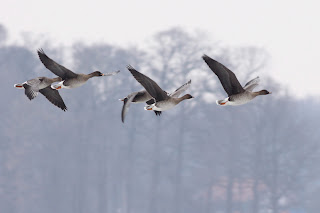Yesterday, Lützen Portengen found minimal 35 Taiga Beans in a flock of Tundra Beans near Udenhout, Brabant. This afternoon, I observed the group for more than two hours. Here some pics on which I will comment later.
Warning: these pictures also include several Tundra's, two orange-billed 1w Greater Whitefronted and other stuff! Have a look...
 |
| Two juvenile albifrons with orange bills. Are they F1 hybrids of a pair of rossicus x albifrons? I couldn't find their parents. |
 |
| All Taiga Bean fabalis foraging in line, as they did the whole time at the edge of the big flock of rossicus. |
 |
| Mix of rossicus and fabalis. 12 of the latter. Note the more slender structure and bowed necks of the birds from the Taiga! |
 |
| Another part of the line of fabalis also mixed with most rossicus. The Taiga birds didn't move a lot. |
 |
| Some just landed albifrons and rossicus in front of the massive group. |
 |
| Some rossicus with two orange bills. Don't think it are fabalis. I followed these birds after landing and concluded that it were two males with type B bills! |
 |
| Neckband from Germany. |
 |
| Two fabalis, just one visible at left. |
 |
| Alert at the background! Part of the line. |
 |
| Alert male with a type A bill. Some more fabalis around, but not visible. |
 |
| Interestingly, the little yellow-billed bird at the left was paired with a straight fabalis. That must be a female! The birds in the centre are more straight forward. |
 |
| rossicus: 1w, ad male type B, ad, ad, ad |
 |
| The same group. |
 |
| Can you do it by yourself? |















